- Hawaii
- Ometepe (Nicaragua)
- The Ridgeway Trail (England)
- The Trossachs and Beyond (Scotland)
- The Stikine River (Alaska/BC)
TEAM: Mike
3 | 5 | 7 | 9 | 10 | 11 | 13–15 | 16 | 17 February
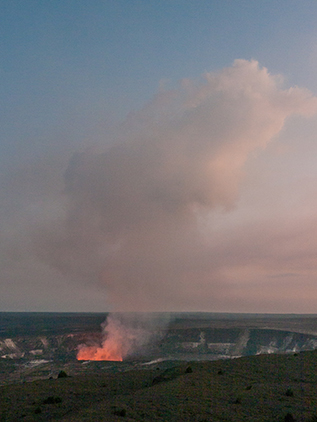
It probably should not surprise anyone that a lot of Alaskans vacation in Hawaii; a lot of friends were going there, this winter. I had been in that state twice before, once courtesy of the US Army and once on a too-short family trip. But neither visit allowed me the time to explore freely. This time, with two weeks spent only on the island of Hawaii, I wanted to focus on volcanoes. I love geology and interesting rocks.
— Mike
Halema’uma’u Crater.
TEAM: Mike
The draw to the island of Ometepe, Nicaragua, in particular, is familial. My daughter and her spouse are spending a year volunteering as English teachers in the village of Merida on Ometepe. Of course, a parent just has to visit! The sights, smells, and sounds I will be surrounded by in the next 20 days will be different from my little part of Alaska. I am bringing along my camera, microphones, and recorders to try to share the sights and sounds.
— Mike
6 | 7 | 8 | 11 | 16 | 18 | 20 | 22 | 23 May
TEAM: Lucy · Troy
In Autumn of 2013, we were walking historic trails in England and Scotland, listening and recording the unique sounds that we hear along the way. As often as I could, I’d post an image and a related recording. The journey starts from Anchorage. An audio travelogue from Both Ears….
— Lucy
10 | 18 | 19 | 20 | 21 | 22 | 23 | 24 | 25 | 27 September

In Autumn of 2013, we were walking historic trails in England and Scotland, listening and recording the unique sounds that we hear along the way. As often as I could, I’d post an image and a related recording. This is the second leg, starting where I left off in Swindon, England (the first leg is the Ridgeway Trail, above), with travel along the West Highland Way (Milngavie to Fort William) and to other places in Scotland. An audio travelogue from Both Ears….
— Lucy
28 | 29 | 30 September
1 | 2 | 3 | 4 | 5 | 6 | 7 | 8 | 9 | 10 | 11 | 12 | 13 | 14 | 15 | 16 | 17 October
What Happened Next? | Last Entry
TEAM: Mike
While Lucy and Troy were wandering around London, I got to spend three days in a very different part of the world, the Stikine River, on a jet boat trip from Wrangell, Alaska, to Telegraph Creek, British Columbia (with sun forecast).
— Mike
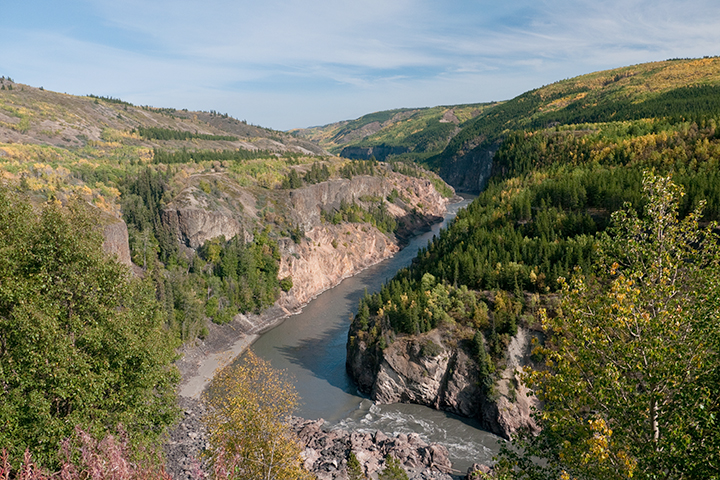
The lower part of the 45-mile-long rapids-filled canyon.
|
The Stikine is the fastest free-flowing river in North America, a muddy river with lots of glaciers dumping silt into the water. The headwaters are in the Spatsizi Plateau in the remote northwest corner of British Columbia in Canada, running 379 Miles (610 km) before emptying into Alaska’s Inside Passage, near Wrangell. It is an international river running through a very sparsely populated wilderness. |
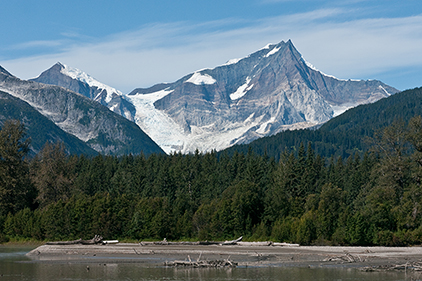 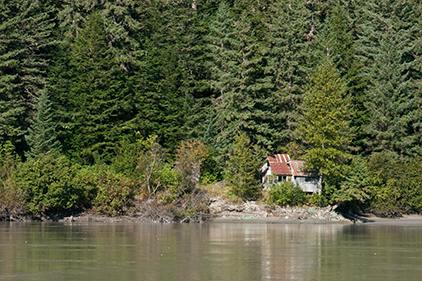
Isolated fishing cabin in Canada. |
|
Telegraph Creek, in British Columbia, is the only permanent settlement along the entire river, home to about 400 people, a mixture of mostly Tahltan First Nation people with a few other homesteaders. The nearest town by road is Dease Lake 90+ miles (150 km) away on a narrow dirt-and-gravel road. The closest town by water is Wrangell, 160 miles (260 km) downriver. This is remote, wild country. |
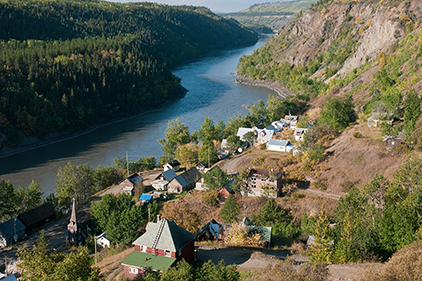
This is the old town site; there are a couple of new collections of houses on the plateau above the river. |
|
Jim Leslie, the owner and operator of the Wrangell-based Alaska Waters, has been a guide for 20 years, touring up the Stikine and in adjacent areas. His boat, the Chutine Warrior, is a jet boat, powered by twin 350hp diesel engines and water pumps for the jet drive capable of filling an Olympic-size swimming pool in four minutes. Jim’s wife Wilma and friend Scott were the crew. Jim gave us the safety info and the boat was underway. We dawdled along for a few minutes while the engines warmed up. For the crossing of the Stikine delta, we needed to be seat-belted in. The boat would be traveling at 30+ mph; if it hit a sandbar, we’d decelerate rapidly. Once we were on the river, seat belts were no longer necessary. |
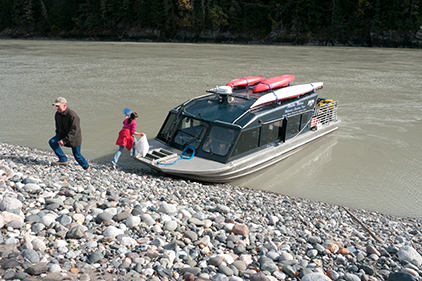
|
|
Two of the three Australian couples on the trip discovered they had friends in common and lived only a mile apart, in Melbourne. Funny to finally meet in Alaska. There were also three kayakers who had floated down from Telegraph Creek and had hired Jim to take them back to their car. The Stikine River draws kayakers and canoeists but is underestimated by many: there are not rapids of any difficulty, but the current is strong and you can find yourself in the wrong spot pretty quickly. That happened to these people, with one capsize and some tense moments in the fast current. |
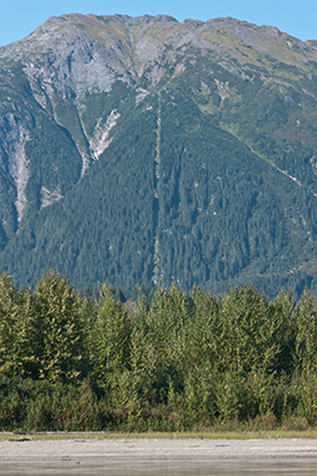
|
|
This late in the summer, water in the river was fairly low, so Jim Leslie had to pay constant attention and “read the water” as the river wound its way up the often broad lower valley and sometimes narrow canyon, avoiding all of the many snags poking out of and just under the water. The river is constantly eroding the river shore and bringing trees down river. |
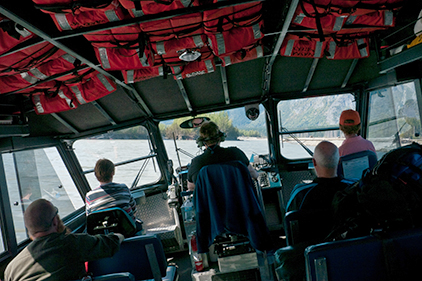
Jim makes a hard left turn to avoid a snag just under the water. 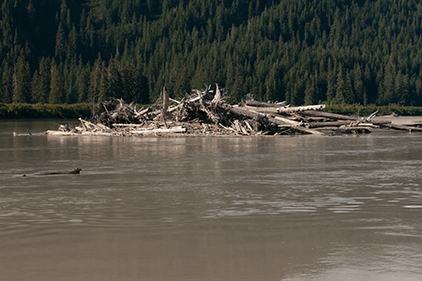
A pile of the many, many trees that get washed out of the shore and start making their way downriver, mostly during high water. |
|
Shortly before the planned hamburger barbecue lunch on a gravel bar, the boat suddenly slowed—moose! There were a bull, cow, and calf moose swimming across the river. A moose trifecta. |
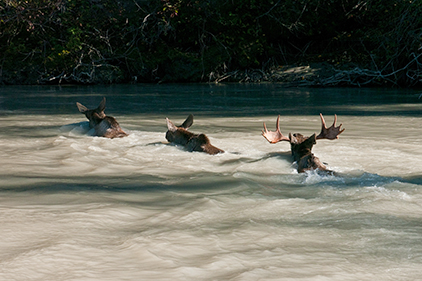
|
|
Over the three days, other than the moose, wildlife were pretty hidden except for ducks flying south and chipmunks looking cute. But, if you didn’t see the animals, you knew they were around from the footprints in the damp sand of the sandbars: moose, bear (both black and grizzly), river otter, wolf, mink…. |
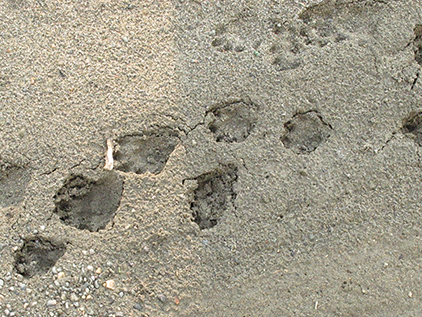 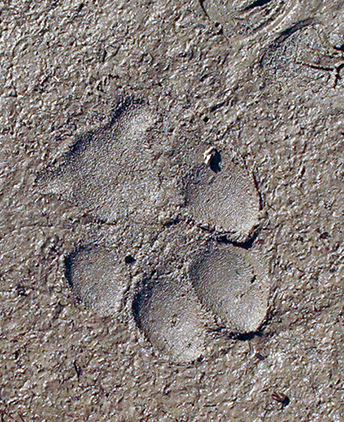
|
|
I took my recording gear along…but, unlike cities, teeming with people and sound, sparsely populated country like this is quiet. No jets overhead, no traffic jams, no trains, no busy-ness, a slower pace of life. It is quiet. About the only sounds were the jet boat, and the occasional old car rattling on the dirt and gravel roads, or the gentle sound of the river rolling toward Wrangell…or maybe just the sound of your own heart. |
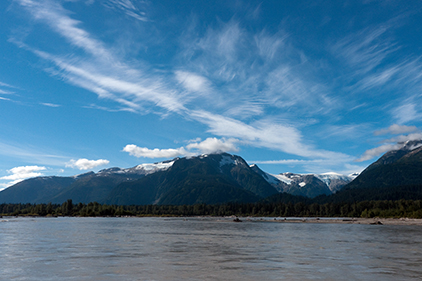
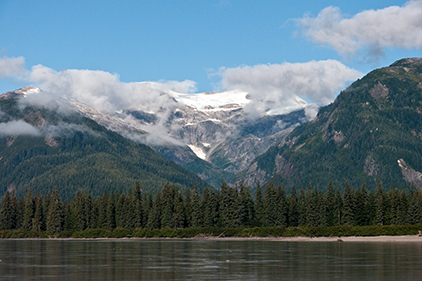 
The sand and gravel bar we had lunch on was covered with an amazing array of different rocks carried her by glaciers and the river. This rock almost looks painted. |